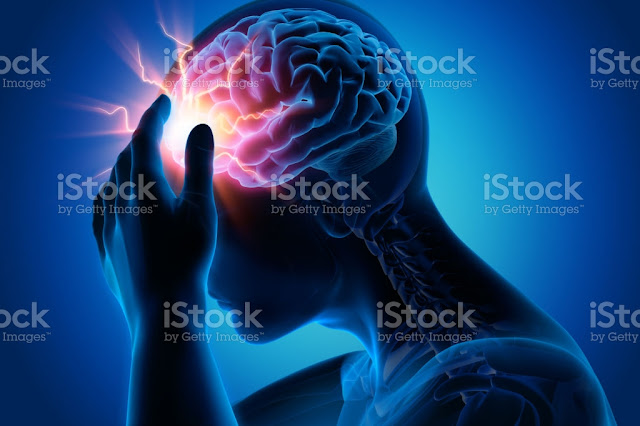Every Head Has Its Own Headache...
While the brain itself has no pain nerve fibers, everything else above the shoulders, from the neck, skull, and face, can cause a person to have head pain. Systematic illness, including infection or dehydration, can have associated headache. These are known as toxic headaches. Changes in circulation and blood flow or trauma can also cause headache. Medication reactions, drug abuse and drug withdrawal can also cause pain.
PRIMARY HEADACHES:
- Tension headache is the most common type of primary headache. The pain usually arises gradually, in the middle of the day. A person may feel:-
- as if they have a tight band around their head
- a constant, dull ache on both sides of the head
- pain spreading to or from the neck
- sensitivity or tenderness around the neck, scalp or shoulder muscles
- intense pressure at the temples or over the eyebrows
- The most likely cause is contraction of the muscles covering the skull is stressed.
- It occurs more commonly among women than men. 1 in 20 people in the developed world suffer with a daily tension headache.
- This type of headache is triggered by emotional stress and physical stressors and most people experience it at some point in their life.
- The physical stressors are:-
- difficult and prolonged manual labor
- sitting at a desk or computer concentrating for long periods
- Even though it is not life threatening, a tension headache can make daily activities more difficult to accomplish.
- Tension-type headaches may be:-
- Episodic --> this attack usually last for a few hours, though it can last for several days
- Chronic --> this involves tension-type headaches occurring on 15 or more days per month for at least 3 months
- Migraine is the
second most common type of primary headache.
- It is a pulsating, throbbing ache
that usually occurs on one side of the head. It can be characterized as an
intense pulling from deep within your head.
- It often occurs on
one side of the head but may switch sides.
- It is caused by
inflammation or irritation of structures that surround the brain or
affects its functions.
- If migraine attacks
run in your family, you are likely to develop the same.
- It affects:-
- children as well
as adults
- before puberty,
boys and girls are affected equally by migraine headache, but after puberty, more women than
men are affected
- it is three times
in women as compared to men
- Its symptoms are:-
- vomiting
- blind spots
- nausea
- lightheadedness
- sensory disturbances, such as change in vision, known as an aura
- People suffering
from migraine headaches are often sensitive to:-
- sound
- light
- A migraine episode may last from a
few hours to 2-3 days. The frequency of episodes can vary greatly; they
may occur from once a week to once a year.
- Many people equate severe headaches
with migraine, but the amount of pain does not determine the diagnosis of
migraine.
- People with migraine often develop
medication overuse headaches.
- It occurs if a person uses
medication to treat headaches too often.
- It tends to result from taking
opiate-based medications, such as those that contain codeine or morphine.
- Beyond the headache, a
person may experience:-
- neck pain
- restlessness
- a feeling of nasal congestion
- reduced sleep quality
- Symptoms can vary, and the
pain may change from day to day.
- This can cause
migraine episodes to occur more frequently and
become more severe.
- Cluster is a rare
type of primary headache.
- It more commonly
affects:-
- men in their late
20s, though women and children can also suffer from this type of headache
- it is three times
more common in men as compared to women
- A burning or
piercing pain around or behind one eye or on one side of the face is
usually the sign of a cluster headache.
- It tends to run in family and this suggests that
there may be a role for genetics.
- It may be triggered by:-
- changes in sleep patterns
- medications (for example, nitroglycerin, used
for heart disease)
- if an individual is in a susceptible period for
cluster headache, cigarette smoking, alcohol and some food (for example,
chocolate and foods high in nitrites like smoked metals, etc.) also are
potential causes
- Its symptoms are:-
- brief but severe pain
- pain around one eye
- redness
- a smaller pupil in one eye
- swelling
- teary eyes
- nasal congestion
and runny
- sweating on the
affected side of the face
- This headache usually lasts
between 15 minutes and 3 hours, and may occur one to eight
times per day.
- It may arise frequently for 4-12
weeks, and then disappear.
- It tends to happen at around the
same time each day.
- People with cluster headaches are restless
and can be driven to desperate measures, including suicidal thoughts.
SOURCE :
· Photos and Videos-
o https://www.pexels.com/
· Content-
o https://www.medicinenet.com/
o https://www.medicalnewstoday.com/
o https://www.combiflam.co.in/
For more blogs please visit: Faultless
Fitness






Nice blog🤟🏻👍🏻
ReplyDeleteWell done..Keep it up...
ReplyDelete